click on the home button to go to the home page
|
The era of Antiquity (cont'd) 1672 - 1769 The era of Antiquity can be seen as the era of calculator
devices that had no memory, no means to output the results other then
dials or indicators. In this period science became less demonized
and more widely accepted for what it was: science. No one was sent
to the burn stake anymore and not all magic was Satan's work anymore.
Though in rural areas the superstition was kept well alive by the
clerics until far into the 19th century. Also economic factors
played a role in the acceptance of pure science and discoveries made
from the practice of science. |
pre history | antiquity
| pre industrial era | industrial
era
1620 -
1672 - 1773 - 1810
- 1830 - 1846 - 1874
| Related Articles |
| Related Resources |
|
|
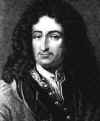 |
Gottfried Wilhelm von Leibnitz (1646-1716 Germany)
a mathematician, physicist, philosopher, theologian, historian and inventor,
started to develop a calculator that would be the next generation of the
Pascaline, the machine became available in 1694.(12) Leibnitz realized that the weakness of the Pascaline laid in the multiplication and division. And also that a commercial successful machine should be working on a different principle. He added a gear with nine teeth of different length providing a mechanism to his machine what could divide and multiply. This was a prime example of how reckoners or other machines like calculating devices were improved upon by different people. |
Leibnitz designed the machine on the principle, or purpose, to mechanize the calculations on trigonometric and astronomical tables.
The same principles that Leibnitz used is still being used centuries later in various machines using the principle of a stepped gear. A construction that had pins mounted on a cylinder that on their turn moved gears in a preset sequence. Leibnitz was the first to use an accumulator (memory alike mechanism).
 Gottfried
Wilhelm von Leibnitz introduced the use of the handle to multiply and
divide to store the results in calculators. Each turn made the cylinders turn
one or part of a revolution. Deep into the 20th century this principle will
be used in calculators
Gottfried
Wilhelm von Leibnitz introduced the use of the handle to multiply and
divide to store the results in calculators. Each turn made the cylinders turn
one or part of a revolution. Deep into the 20th century this principle will
be used in calculators
Leibnitz also wanted to develop a generalized symbolic language and an algebra to go with his machines, so that:
"the truth of any proposition in any field of human inquiry could be determined by simple calculation."
This quest was unsuccessful, but he did invent the calculus and devised and promoted much of modern mathematical notation still in use today.
On the subject of calculation, Leibnitz wrote:
"It is unworthy of excellent men to lose hours like slaves in the labor of calculation which could safely be relegated to anyone else if machines were used."
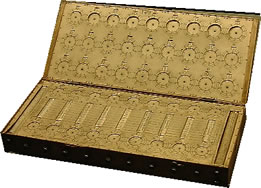
![]() This calculator
contains 7 "Napiers" rollers and is made of wood and parchement by
a watchmaker called Grillet. (6)
This calculator
contains 7 "Napiers" rollers and is made of wood and parchement by
a watchmaker called Grillet. (6)
![]()
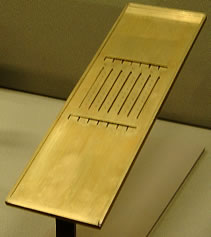 Perrault,
conservator of the Louvre, designed an early handheld calculator with carrying
of tens. This one appeared to have been more a curiosity than a commercial calculator.
That was quite normal is this era: the enlightenment and interbellum.
It were the salons in the French kingdom that pushed the success of gadgets
like this. And as a spin off science advanced rapidly too because no longer
scientist were seen as people playing with some childish toys to amuse them
selves. (6)
Perrault,
conservator of the Louvre, designed an early handheld calculator with carrying
of tens. This one appeared to have been more a curiosity than a commercial calculator.
That was quite normal is this era: the enlightenment and interbellum.
It were the salons in the French kingdom that pushed the success of gadgets
like this. And as a spin off science advanced rapidly too because no longer
scientist were seen as people playing with some childish toys to amuse them
selves. (6)
![]() Isaac Newton (England)
established his laws of kinetics and gravity and published these laws in his
Philosophiae Naturalis Principia this book also became known as: Principia
Mathematica. This work proved to be one of the fundamental cornerstones
on which the western science would base its progress in and view on the physical
world around us.
Isaac Newton (England)
established his laws of kinetics and gravity and published these laws in his
Philosophiae Naturalis Principia this book also became known as: Principia
Mathematica. This work proved to be one of the fundamental cornerstones
on which the western science would base its progress in and view on the physical
world around us.
Newton is the exact opposite of Leibnitz. The latter is a man of the world and publishes freely on the infinitesimal mathematics, that were developed by both Newton and Leibnitz independently of each other though. In how far communications have been established between Newton and Leibnitz will remain uncertain. Fact was that Newton kept his knowledge close to his chest and did very secretive about his knowledge in contrast with Leibnitz who published whenever he could. That made Newton to publish his findings too in a way, forced by Leibnitz's publications, though even the infinitsimal mathematics publication itself was not of Newton's own hand.
|
Integral Arithmetic Infinitesimal calculation pushed not only the mathematical sciences
ahead, all Beta sciences profited. Without this knowledge various
sciences would have had to struggle for years with questions unanswered,
but that were now answered more easily by this new knowledge. Especially
astronomers made a giant leap ahead. One could say that the world
of astronomy got totally upside downed. |
![]() Newton's publication pushed
Christiaan Huygens to publish his work on the theory of light what he had developed
during the last ten years: Traité de la Lumière (Treatise of Light).
This work was of great influence on the theory of light and further development
of the theoretical aspects of light. His work still shines in the excellence
of the mathematical foundations on which he based the theorems used in his treatise.
Newton's publication pushed
Christiaan Huygens to publish his work on the theory of light what he had developed
during the last ten years: Traité de la Lumière (Treatise of Light).
This work was of great influence on the theory of light and further development
of the theoretical aspects of light. His work still shines in the excellence
of the mathematical foundations on which he based the theorems used in his treatise.
![]() G. W. Leibnitz (Germany)
built a machine that beside the basic calculations also could take the
root from a number. The last three calculations were done by adding or subtracting
repeatingly. A principle that is still used in 20th century calculators.
G. W. Leibnitz (Germany)
built a machine that beside the basic calculations also could take the
root from a number. The last three calculations were done by adding or subtracting
repeatingly. A principle that is still used in 20th century calculators.
Thesis: Calculating the square root of a number is a mathematical process.
Definition: The square root of a number is a number that when raised one or more times with itself gives back the original number.

![]() Leibnitz invented
the binary calculus. But his method soon gathered dust also because of his absence.
Since he sought refuge with the Emperor of China. In this era most of the people
still thought that the world is flat and maybe because of that people did not
travel far: out of sight out of heart.
Leibnitz invented
the binary calculus. But his method soon gathered dust also because of his absence.
Since he sought refuge with the Emperor of China. In this era most of the people
still thought that the world is flat and maybe because of that people did not
travel far: out of sight out of heart.
But Leibnitz travelled all the way to China which was only known to a very few
people. and so he and his theories were completely forgotten. Leibnitz was also
taking to the theosophical approach for the binary arithmetic in a way not taken
well by many scientists (4) so he dropped
in their view literally from the world.![]()
![]() Mechanical
calculators were improved upon to such a degree that the main principles became
better known and many inventors improved and expanded on machines that were
already on the market. But speaking of a market might be a bit overdone in view
of this era: the machines were few and expensive.
Mechanical
calculators were improved upon to such a degree that the main principles became
better known and many inventors improved and expanded on machines that were
already on the market. But speaking of a market might be a bit overdone in view
of this era: the machines were few and expensive.
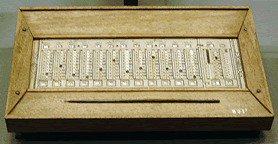
![]() Caze developed
a calculator that transported the twelfth's and parts thereof that suited very
well the ancient French monetary system. The calculator is placed in a leather
casing, with rolls that could be moved by a wooden pin (see bottom of picture).
The rolls look like they were made of paper or parchment.(6)
Caze developed
a calculator that transported the twelfth's and parts thereof that suited very
well the ancient French monetary system. The calculator is placed in a leather
casing, with rolls that could be moved by a wooden pin (see bottom of picture).
The rolls look like they were made of paper or parchment.(6)
![]() Jonathan
Swift (England) described a machine that wrote books automatically in: Gulliver's
Travels. A revolutionary idea that even in the 21st century is not yet
fully realized.
Jonathan
Swift (England) described a machine that wrote books automatically in: Gulliver's
Travels. A revolutionary idea that even in the 21st century is not yet
fully realized.
![]() Antonius
Braun (Austria) developed the first calculator with the four base calculations:
add - subtract - multiply and divide.
Antonius
Braun (Austria) developed the first calculator with the four base calculations:
add - subtract - multiply and divide.

The one shown in the picture was an exquisite example of craftsmanship of the 18th century handworkers. A machine also had to be esthetically nice to the eye was a very common thaugth.
![]() Almost Identical
to the above calculator Jacob Leupold designed a
circular machine based on the principles of Leibnitz.
Almost Identical
to the above calculator Jacob Leupold designed a
circular machine based on the principles of Leibnitz.
Its principle was to disengage the gear wheel when the required number of teeth had meshed with the counter.
![]() Falcon (France)
designed the first programmable loom. He used wooden punched cards tied together
with ropes. This was the first punched card ever. The Intricate figures and
patterns woven into the fabric were related to the positions of the holes in
the punched cards. The combinations of the holes in the cards were the instructions
to the loom mechanism. This is what we now usually call the first program ever.
Falcon (France)
designed the first programmable loom. He used wooden punched cards tied together
with ropes. This was the first punched card ever. The Intricate figures and
patterns woven into the fabric were related to the positions of the holes in
the punched cards. The combinations of the holes in the cards were the instructions
to the loom mechanism. This is what we now usually call the first program ever.
The invention of the punched card meant the beginning of automation.
Because automation means that a machine can perform a sequence of actions without
interference of a human being. The human limits its actions by starting the
machine. And before a machine could do anything all actions (instructions) should
be laid down in some (physical) form to achieve a preset goal in advance. In
this perspective the set of instructions laid down in the punched cards can
be called a program(5) (see also Jacquard
1801/5)
Ada Lovelace (UK) will develop this idea further over a century later.
Herman Hollerith (USA),
again a bit later, also took upon this idea of instruction cards to improve
the speed and simplicity of data entry with his punched cards .
But it is very plausible that Hollerith got his idea independently of Falcon's
invention. That happened with similar inventions realized into practical products
by many independent inventors. Especially in this period of time where communication
is minimal between scientist.
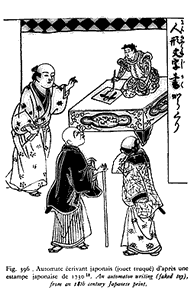 |
This illustration shows a human calculator in Japan.
In Japan these calculators were in very high esteem and people went to
professional calculators as to scribents to have them make a calculation
or write business oriented papers such as contracts or inventory lists. |
 |
Benjamin Franklin in Philadelphia (USA) set up lightning rods after he found out that lightning is a form of electricity. When he was kiting during a storm and used a key to serve as a conductor he got literally shocked. His experiments eventually led to the reinvention of the battery as did the Egyptians centuries before; a primitive battery was found in a tomb beneath a pyramid. Some years later Volta developed a somewhat less risky form of electricity and developed a more permanent battery. |
![]() James Watt
(England) invented the steam engine. This is the engine that started the Industrial
Revolution. The steam drove other machines and made many workers over complete.
Opf course this caused unemployment and thus social unrest. The engines coming
forth from this technology will change the face of the earth within a few decades.
James Watt
(England) invented the steam engine. This is the engine that started the Industrial
Revolution. The steam drove other machines and made many workers over complete.
Opf course this caused unemployment and thus social unrest. The engines coming
forth from this technology will change the face of the earth within a few decades.
![]()
 Nearing
the end of the 18th century the advances in watch making technology spurred
rapid developments in mechanics. One of this advancements drew the attention
of the chess loving public. A machine was created that was said to play chess
at a master level. This "machine" was named "The Turk" causing
a sensation when it was exhibited all across Europe and America for nearly a
century. (ref Gary A. Thomas)
Nearing
the end of the 18th century the advances in watch making technology spurred
rapid developments in mechanics. One of this advancements drew the attention
of the chess loving public. A machine was created that was said to play chess
at a master level. This "machine" was named "The Turk" causing
a sensation when it was exhibited all across Europe and America for nearly a
century. (ref Gary A. Thomas)

![]() The
first chess playing machine ever was invented by the famous Hungarian engineer
and inventor Baron Wolfgang von Kempelen
who was Counselor on mechanics to the Austrian royal court. He first exhibited
the contraption at the Viennese Royal Palace in 1769. The Baron claimed that
the machine could play chess and wound it up with a key after which he invited
members of the audience to inspect the device and to play against it. It was
in fact a hoax; but no one discovered the secret. The automaton was big enough
to hide the small person inside who operated it. After the death of the inventor,
the Turk had become so famous that it continued to make world tours. In 1809
at an exhibition in Shoenbrunn, the Turk played a famous game against Napoleon
1st. The Turk was destroyed in a fire at the museum of Philadelphia in 1856.
Other automata were invented later and continued to perform. Most notably amongst
them were Ajeeb and Mephisto which
worked in a similar fashion. (Ref Gary A. Thomas)
The
first chess playing machine ever was invented by the famous Hungarian engineer
and inventor Baron Wolfgang von Kempelen
who was Counselor on mechanics to the Austrian royal court. He first exhibited
the contraption at the Viennese Royal Palace in 1769. The Baron claimed that
the machine could play chess and wound it up with a key after which he invited
members of the audience to inspect the device and to play against it. It was
in fact a hoax; but no one discovered the secret. The automaton was big enough
to hide the small person inside who operated it. After the death of the inventor,
the Turk had become so famous that it continued to make world tours. In 1809
at an exhibition in Shoenbrunn, the Turk played a famous game against Napoleon
1st. The Turk was destroyed in a fire at the museum of Philadelphia in 1856.
Other automata were invented later and continued to perform. Most notably amongst
them were Ajeeb and Mephisto which
worked in a similar fashion. (Ref Gary A. Thomas)
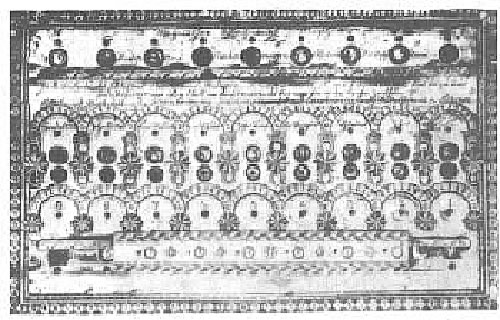
In the second half of the 18-th century this adding machine was created in the city of Nesvige. The inscription made on this machine, says, that it is invented and made by “Gevna Jacobson, watchmaker and mechanician in the city Nesvige in Lithuania, Minsk province ”. The machine is now part of the collection of scientific tools of the museum Lomonosov in Leningrad.(7)
![]()
| |
Last Updated on 01-Oct-2004 | For suggestions please mail the editors |
Footnotes & References